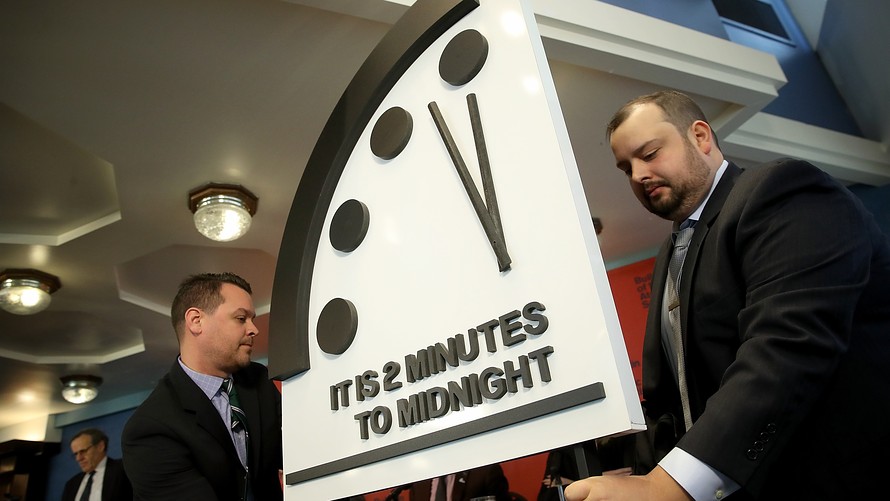Doomsday clock has world at two minutes from Armageddon
"Though unchanged from 2018, this setting should be taken not as a sign of stability but as a stark warning to leaders and citizens around the world."

By Denise Chow and Minyvonne Burke
Humanity is just two minutes from Armageddon, the same as last year but still the closest the world has inched to symbolic doom since 1953, at the height of the Cold War.
That was the bleak outlook from the Bulletin of the Atomic Scientists, the nonprofit organization that oversees the Doomsday Clock — the symbolic timepiece that represents humanity’s perceived proximity to a human-caused apocalypse.
Citing nuclear arms races, threats of cyberattacks and ongoing climate change, the clock’s minute hand was not moved from 2018, the organization announced Thursday morning, saying we are living in a time with multiple existential threats.
"We are calling this the new abnormal, a disturbing reality in which things are not getting better," Robert Rosner, a theoretical physicist at the University of Chicago and chair of the Bulletin's science and security board, said at a news conference. "We appear to be normalizing a world in which the risks of nuclear warfare and climate change, unchallenged, are ever more present and are not being effectively dealt with."
The decision to keep the Doomsday Clock at two minutes to midnight was driven by the dangers of this "new abnormal," said Rachel Bronson, president and CEO of the Bulletin of the Atomic Scientists.
"Though unchanged from 2018, this setting should be taken not as a sign of stability but as a stark warning to leaders and citizens around the world," Bronson said in a statement.
The Doomsday Clock doesn’t represent a real prediction of calamity, but is instead used as a visual metaphor for how close the world is to a potentially civilization-ending catastrophe.
Sharon Squassoni, a research professor at George Washington University and a member of the Bulletin's science and security board, said the failure of President Donald Trump and other world leaders to negotiate new arms control initiatives and uphold existing ones threatens decades of work to reduce nuclear risks.
"Arms races seem preferred to arms control and nonproliferation agreements," Squassoni said. "If this is indeed an era of great power competition, then it deserves great solutions that walk us back from the brink of nuclear conflict, not toward it."
Bulletin officials also said the world is losing ground in the fight against climate change, with global emissions of carbon dioxide continuing to rise. In the U.S., a strengthening economy has contributed to an increase in carbon dioxide emissions after several years of decline, according to a report released this month by the Rhodium Group, an independent research firm that tracks climate change and economic policy in the U.S.
Another factor that influenced this year's Doomsday Clock setting is what Herb Lin, a senior research scholar for cyber policy and security at Stanford University and a member of the Bulletin's board, called "cyber-enabled information warfare."
Fueled by an already polarized political climate, Lin said the insidious of cyber technology has eroded trust in science and democratic institutions.
"Propaganda and lies have been around for a very long time," Lin said, "but in the internet age, the volume and velocity of information is increased by orders of magnitude."
Each year, the Bulletin consults with a board of sponsors that includes 14 Nobel Laureates to analyze a wide array of threats to determine where the Doomsday Clock’s hands should be set.
The Bulletin of the Atomic Scientists was founded in 1945, and the group has maintained the Doomsday Clock since 1947.
No comments:
Post a Comment